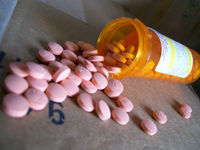 Subscribe
SubscribeWest Africa: trafficking central station?
West Africa is affected by a number of illicit commercial flows. Some of these originate in the region, such as those involving stolen oil, undocumented migrant labourers, or sex workers. Others are destined for the region, such as toxic waste, firearms, or counterfeit medication. Still others merely transit the region, such as cocaine. In each case, though, these flows leave their imprint on West Africa.
Here Francis Maertens and Amado Philip de Andrés of the United Nations Office on Drugs and Crime (UNODC) attempt to assess and compare these imprints. Click on a tab below to find out more.
What are the policy options?
Economic monoculture can also feed bad governance, a problem often described as “the resource curse”. Paul Collier and other analysts have noted that dependence on primary commodity exports increases the risk of civil war.
On the other hand, West Africa has become afflicted with organised crime because its immunity is low, but the pathogens themselves are mostly foreign in origin. The region is caught up in illicit commercial flows facilitated by locally-based criminals. In each case, at least one component of the supply chain lies outside West Africa. The problems are transnational challenges, and this means there are at least two broad ways of coming up with solutions in the form of policy options.
The problems are transnational challenges, and this means there are at least two broad ways of coming up with solutions in the form of policy options.
The first is to address those aspects of the problem that lie outside the region. In many cases, this is the easier path, since law enforcement capacity in West Africa is among the lowest in the world. Curbing the demand for stolen oil, limiting the supply of substandard medication, curtailing the processing of illicit goods in free trade zones, regulating the global second-hand electronics market, regularising the status of migrant labour, enhancing transparency in financial transfers: bringing order to these global commercial flows would go a long way toward relieving West Africa’s pain.
The second is the long-term project of improving West Africa’s immunity through building the rule of law, which is what UNODC has been doing in the last five years, together with key partners such as ECOWAS, the UN Department for Peacekeeping Operations (DPKO), INTERPOL, the United Nations Office for West Africa (UNOWA), etc. This is not necessarily as daunting as it might sound. Removing the profitability of intraregional cigarette smuggling can be accomplished through the harmonisation of licensing and taxation regimes, for example. The regulation of waste and medical supplies is essentially a technocratic issue. The building of healthy states is the final goal, although there are numerous incremental steps along the way that could pay immediate dividends in reducing the environment of lawlessness.
In both approaches – transnational and local – the involvement of the international community is the quintessence to sustainable success. Unilateral remedial action by any West African state will surely be undermined by less progressive practices in its neighbours, particularly given the weakness of borders in the region.
Francis Maertens is Director, Division for Operations, and Deputy Executive Director, United Nations Office on Drugs and Crime (UNODC). Amado Philip de Andrés is in charge of developing programmes in the Integrated Programming Unit, Division for Operations, UNODC and formerly UNODC Deputy Representative for West and Central Africa.
West Africa is affected by a number of illicit commercial flows. Some of these originate in the region, such as those involving stolen oil, undocumented migrant labourers, or sex workers. Others are destined for the region, such as toxic waste, firearms, or counterfeit medication. Still others merely transit the region, such as cocaine. In each case, though, these flows leave their imprint on West Africa.
Here Francis Maertens and Amado Philip de Andrés of the United Nations Office on Drugs and Crime (UNODC) attempt to assess and compare these imprints, based on the UNODC report published in July 2009 entitled Transnational Trafficking and the Rule of Law in West Africa: A Threat Assessment.

 RSS
RSS




